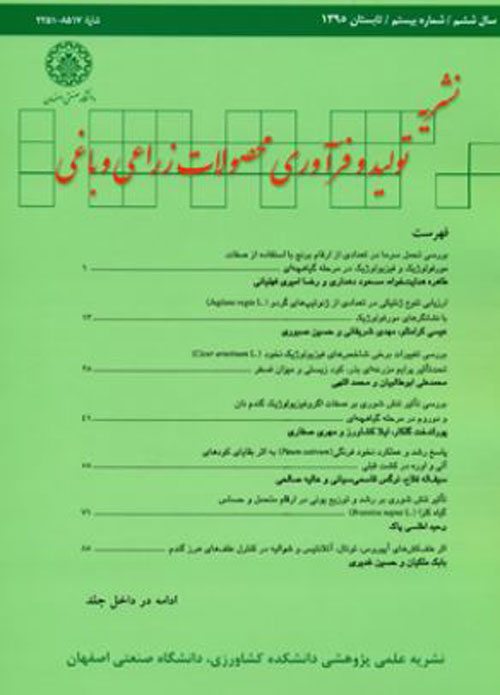Evaluation of Yield, SPAD Index, Landuse Efficiency and System Productivity Index of Barley (Hordeum vulgare) Intercropped with Bitter Vetch (Vicia ervilia)
Author(s):
Abstract:
This experiment was performed to investigate the possibility of barley-bitter vetch intercropping under field conditions, based on factorial using randomized complete blocks design with three replications, at the Agricultural Research Station of Bu-Ali Sina University, Hamadan, Iran. Treatments were sole cropping of barley (200, 300 and 400 plants/m2 densities), sole cropping of bitter vetch (20, 40 and 60 plants/m2 densities) and additive intercropping based on combination of the two species. Results revealed that the effects of treatments were significant for number of seeds per spike, flag leaf chlorophyll, grain yield and biological yield of barley. Interaction of barley density× bitter vetch density significantly affected only grain and biological yields of barley. Maximum number of seeds/spike (22.25) and leaf chlorophyll (43.38 SPAD) was achieved at 200 and 400 barley plants/m2, respectively. Also, maximum plant height (43.8 cm) and number of seeds/spike of barley (22.78) and minimum value of these traits (32.9 cm and 17.22 seeds/spike, respectively) was observed in barley sole-cropping and intercropping (adding of 60 bitter vetch seeds/m2 to barley densities), respectively. Sole cropping of barley at 400 plants/m2 density produced the highest grain and biological yield (288 g/m2 and 564 g/m2, respectively) which was not significantly different from 300 plants/m2 treatment (260 g/m2 and 555 g/m2, respectively). Plant height, number of pods/plant and leaf chlorophyll of bitter vetch were significantly affected by barley densities. Maximum plant height (20 cm) and leaf chlorophyll (46.83 SPAD) were observed at adding of 400 barley plants/m2 to bitter vetch densities. Maximum number of pods/plant (9.22) was in sole cropping of bitter vetch. Also, comparison of bitter vetch densities revealed that 60 plants/m2 was superior to 20 and 40 plants/m2 densities. Maximum land equivalent ratio (LER=1.81) and system productivity index (SPI=4526) were achieved at intercropping of barley and bitter vetch with densities of 300 and 20 plants/m2, respectively. Therefore, it seems that intercropping of low density of bitter vetch (20 plants/m2) with normal density of barley (300 plants/m2) may give better overall yield and income than sole cropping of barley.
Keywords:
Language:
Persian
Published:
Journal of Crop production and processing, Volume:2 Issue: 2, 2012
Pages:
79 to 92
magiran.com/p1470810
دانلود و مطالعه متن این مقاله با یکی از روشهای زیر امکان پذیر است:
اشتراک شخصی
با عضویت و پرداخت آنلاین حق اشتراک یکساله به مبلغ 1,390,000ريال میتوانید 70 عنوان مطلب دانلود کنید!
اشتراک سازمانی
به کتابخانه دانشگاه یا محل کار خود پیشنهاد کنید تا اشتراک سازمانی این پایگاه را برای دسترسی نامحدود همه کاربران به متن مطالب تهیه نمایند!
توجه!
- حق عضویت دریافتی صرف حمایت از نشریات عضو و نگهداری، تکمیل و توسعه مگیران میشود.
- پرداخت حق اشتراک و دانلود مقالات اجازه بازنشر آن در سایر رسانههای چاپی و دیجیتال را به کاربر نمیدهد.
In order to view content subscription is required
Personal subscription
Subscribe magiran.com for 70 € euros via PayPal and download 70 articles during a year.
Organization subscription
Please contact us to subscribe your university or library for unlimited access!



